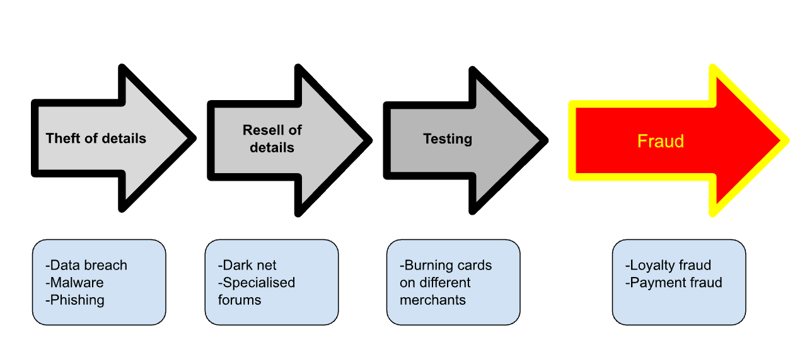Airline Fraud
Flying High but Not Safe: Tackling Fraud in the Airline Industry
FRAUD
2/9/20246 min read


Airlines around the globe are facing fraud daily through various schemes. Our focus here is to show the tactics used by fraudsters who exploit payment systems to buy flight tickets without bearing any costs, leaving others to foot the bill. This phenomenon affects the airlines and extends its repercussions to cardholders, financial institutions, and the broader community due to its association with criminal undertakings. Regrettably, such instances of airline fraud are a form of organized crime.
The objectives behind these criminal activities are diverse, ranging from transporting illicit goods and individuals to laundering money or securing financial advantages by selling these tickets and funneling the proceeds back into further illegal operations. These criminals are organized, intelligent, sophisticated, persistent, and adapt quickly to changing circumstances. They represent a continuous threat and show no signs of ceasing their activities.
Exploring the Various Manifestations of Airline Fraud
The airline industry faces several types of fraud, each exploiting different aspects of its operations. Understanding these fraudulent practices is crucial for consumers and providers in safeguarding against them.
Card-Not-Present (CNP) Fraud in Online Purchases
CNP fraud is a prevalent issue where fraudsters, armed with an understanding of travel industry operations, book flights for near-term departures at any ticket value via airlines and Online Travel Agent (OTA) platforms. Payment is made using stolen credit or debit card details or compromised e-wallets.
Chargeback Fraud, Also Known as Friendly Fraud
This fraud occurs when a customer purchases a ticket, completes their travel, and then initiates a chargeback, falsely claiming the transaction was unauthorized or the service was not provided, aiming to secure free travel. In such cases, if the chargeback claim is successful, the cost falls on the OTA.
Loyalty Program Fraud
Fraudsters target Frequent Flyer Programs (FFPs) through phishing, password hacking, and social engineering tactics, sometimes even compromising airline employees to access member accounts. Once they gain access, they either book resale tickets or redeem miles for offers with partner companies.
Ticket Cancellation Scheme
In this scheme, fraudsters use stolen credit card information to book flights and earn airline reward points. These points are then used to purchase more tickets or are resold for profit.
Fraud through Fake Travel Agent Sites
Also known as a triangulation scheme, this fraud involves unsuspecting customers paying discounted tickets on fraudulent OTA websites. The fraudster then purchases the ticket from the airline or a legitimate OTA using a stolen credit card, leaving the customer with a ticket bought under fraudulent circumstances.
In-Flight Fraud
Fraudsters exploit the offline status of onboard payment terminals to purchase duty-free products with counterfeit credit cards, knowing that immediate authorization is impossible.
Baggage Fraud
This type of fraud involves declaring checked baggage lost upon arrival and filing claims for supposedly high-value contents, often supported by fake receipts to substantiate insurance claims.
Addressing these varied fraud schemes requires vigilance and a multi-faceted approach from industry stakeholders and customers, underscoring the importance of security measures and awareness in the fight against airline fraud.
How do fraudsters typically operate:
The impacts of fraud on merchants:
The impact of fraud on merchants, particularly within the airline industry, stands as a significant concern. Notably, the airline sector bears the brunt of online fraudulent activities, representing 46% of such transactions. The money transfer and computers/electronics sectors experience considerably lower fraud rates, at 16% and 13%, respectively. Fraudulent activities often focus on high-value airline tickets, such as first and business class.
The International Air Transport Association (IATA) has quantified these fraudulent transactions to cost the airline industry at least $1 billion annually, which equates to approximately 1.2% of its yearly revenue. Beyond the direct financial losses, airlines must also contend with ancillary repercussions such as reputational damage and the costs associated with fraud prevention technologies and operational adjustments. These factors collectively exert substantial pressure on the profitability of airlines and Online Travel Agencies (OTAs), not to mention the potentially severe consequences of card scheme fraud programs.
Geographically, the prevalence and nature of airline fraud vary. Argentina, Brazil, and Mexico experience the highest frequency of fraudulent attempts. At the same time, other regions like China, the USA, and France are known for more sophisticated forms of fraud, including account takeovers, bots, and fake proxies.
Moreover, companies are caught in a challenging position as they strive to balance the desire for a seamless user experience against the need for enhanced security measures. The emphasis on minimal friction has led to a rise in authentication steps, reflecting the industry's broader struggle with security vulnerabilities. This issue is underscored by the significant data breaches several major companies have endured in recent years, highlighting critical weaknesses in the technological and human aspects of their security frameworks.
How effective are airlines in combating this type of crime?
Businesses are grappling with the challenge of delivering a seamless user experience while integrating more steps into their security protocols. In the airline industry context, the impact of payment fraud is quantified through the gross volume of chargebacks and declined bookings. Striking a delicate balance between robust security measures and maintaining a high rate of successful payments is essential, yet many organizations find this challenging.
Globally, the average rejection rate for bookings stands at 3.8%, but this figure notably doubles in North America. This suggests North American airlines might inadvertently turn away legitimate transactions in their quest for heightened caution. It's commonplace for entities within the airline sector to employ fraud prevention systems or dedicated teams. Sometimes, a more intricate approach is described as an ecosystem of fraud prevention strategies. This comprehensive system, which integrates multiple tools and processes, is particularly prevalent in areas with significant fraud activity, such as Argentina. Some companies outsource their fraud prevention efforts entirely or partly, depending on their strategic preferences. There is no universal solution that fits every scenario.
Several companies face constraints due to insufficient internal resources or lack of expertise, which is understandable given the high percentage of direct airline bookings requiring manual review. Additionally, some are hindered by a lack of necessary technology, including capabilities for monitoring various Key Performance Indicators (KPIs). Others find it challenging to stay compliant as regulatory frameworks evolve, necessitating updates in reporting requirements and adjustments to thresholds specific to each country or region.
What Airlines and OTAs Require to Combat Fraud
To enhance their defense against fraud, airlines must first understand the methods by which fraud is committed. This understanding is crucial for implementing best practices in fraud detection and prevention. Essential measures include real-time authorization of credit card transactions and securing Card Verification Numbers (CVN), which 78% of airlines already utilize. Additionally, half of the USA, UK, and Canada airlines verify cardholder addresses through the Address Verification Service (AVS), adding an extra layer of security. A significant majority, 86%, of airlines are using or planning to implement 3D Secure technology. This system guards against fraudulent chargebacks and shifts liability in most instances.
It's worth noting that within the European Union, the Payment Services Directive 2 (PSD2) mandates the use of 3D Secure. Airlines must invest in technological solutions to combat fraud effectively and ensure a secure, seamless purchasing experience for their customers. These solutions detect and counteract fraudulent tactics and enhance decision-making capabilities.
Effective fraud management requires a delicate balance: detecting and rejecting fraudulent orders accurately, managing the operational costs associated with anti-fraud measures efficiently, and maximizing the acceptance of legitimate orders to ensure a positive customer experience.
Furthermore, staying abreast of the latest trends and strategies in fraud prevention is vital. Airlines can achieve this through participation in fraud forums, events, and consulting industry publications. Adopting a comprehensive approach to fraud management across the entire organization, rather than channel-by-channel, is essential. Integration of fraud management into the roadmaps of various teams—including product, IT, and payments—is crucial.
The advent of advanced analytics and the integration of high-quality data sources have significantly improved the efficiency and effectiveness of fraud management strategies, thereby reducing costs. Machine Learning (ML) is at the forefront of these advancements, enhancing decision-making speed, accuracy, and cost-effectiveness.
Offering alternative payment methods is another strategy to mitigate risk. Specific payment methods, such as open banking and some e-wallets, are inherently less risky. Presenting only these alternative payment methods to customers can be effective in suspicious transactions. However, it's essential to recognize that these methods may not always be the preferred choice for customers due to the perks offered by traditional card schemes, such as loyalty points.
For further insights on effectively combating airline fraud, reducing operational costs, or enhancing your system's efficiency, please don't hesitate to contact us.


CONTACT US
contact@quarenta.se


